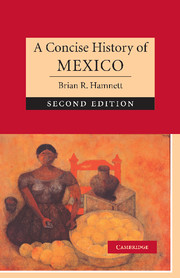Book contents
- Frontmatter
- Contents
- List of illustrations
- Chronology
- Preface to the second edition
- Preface to the first edition
- 1 Mexico in perspective
- 2 The pre-Columbian era
- 3 The European incursion, 1519–1620
- 4 New Spain, 1620–1770: Spanish colonialism and American society
- 5 Destabilisation and fragmentation, 1770–1867
- 6 Reconstruction, 1867–1940
- 7 The monopoly party, 1940–2000
- 8 The Fox administration, 2000–2006
- 9 Cultural developments since Independence
- Final comments
- Bibliography
- Index
- Titles in the series
2 - The pre-Columbian era
Published online by Cambridge University Press: 05 June 2014
- Frontmatter
- Contents
- List of illustrations
- Chronology
- Preface to the second edition
- Preface to the first edition
- 1 Mexico in perspective
- 2 The pre-Columbian era
- 3 The European incursion, 1519–1620
- 4 New Spain, 1620–1770: Spanish colonialism and American society
- 5 Destabilisation and fragmentation, 1770–1867
- 6 Reconstruction, 1867–1940
- 7 The monopoly party, 1940–2000
- 8 The Fox administration, 2000–2006
- 9 Cultural developments since Independence
- Final comments
- Bibliography
- Index
- Titles in the series
Summary
Migrating hunters in pursuit of animals during the Ice Age may have crossed the land bridge from Asia, now the Bering Straits, into the American continent some 12,000 years ago. Controversy still surrounds both provenance and dating, although this seems to be the preferred explanation for the populating of the Americas. At the end of the Ice Age, the land was less able to sustain large, foraging population groups. With the extinction of the hunted mastodons around 8000 bc, hunters needed to find a new balance between nutritional needs and their environment's food potential. For several thousand years, however, foraging and farming coexisted, before maize cultivation became the basis of the economy. The domestication of plants required regular rainfall or proximity to fresh water. Similarly, the need for tools led to the development of trade routes, especially between highland sources of obsidian, the principal cutting agent, and the tropical lowlands with their diversity of foodstuffs.
Agriculture possibly developed in Mesoamerica between 5500 bc and 3500, considerably later than in Syria and Mesopotamia, where cultivation of wheat began around 9000 bc and 8000 bc respectively, and in the Indus Valley, where barley cultivation began around 7000 bc. In the central Mexican Basin, pre-ceramic society, a mixture of sedentary and semi-sedentary peoples, existed possibly around 4000 bc, taking nourishment from the plant and animal life around the extensive lakeshore of the Valley of Mexico.
- Type
- Chapter
- Information
- A Concise History of Mexico , pp. 22 - 57Publisher: Cambridge University PressPrint publication year: 2006



